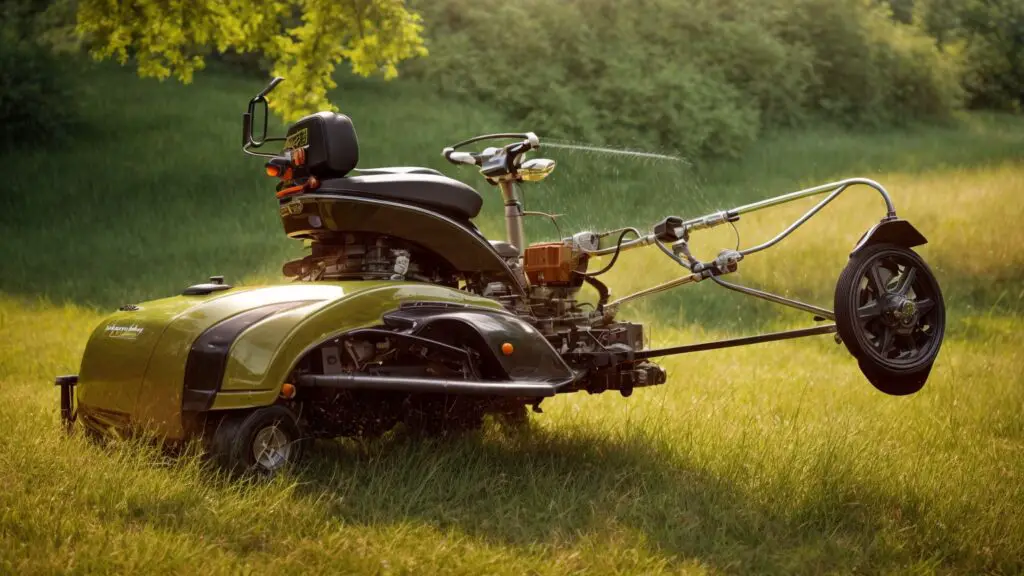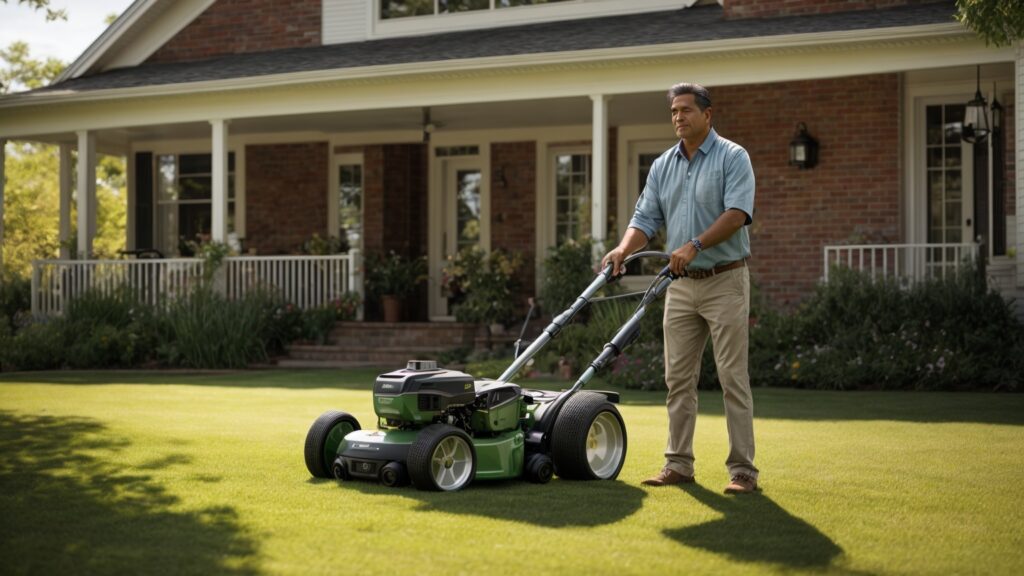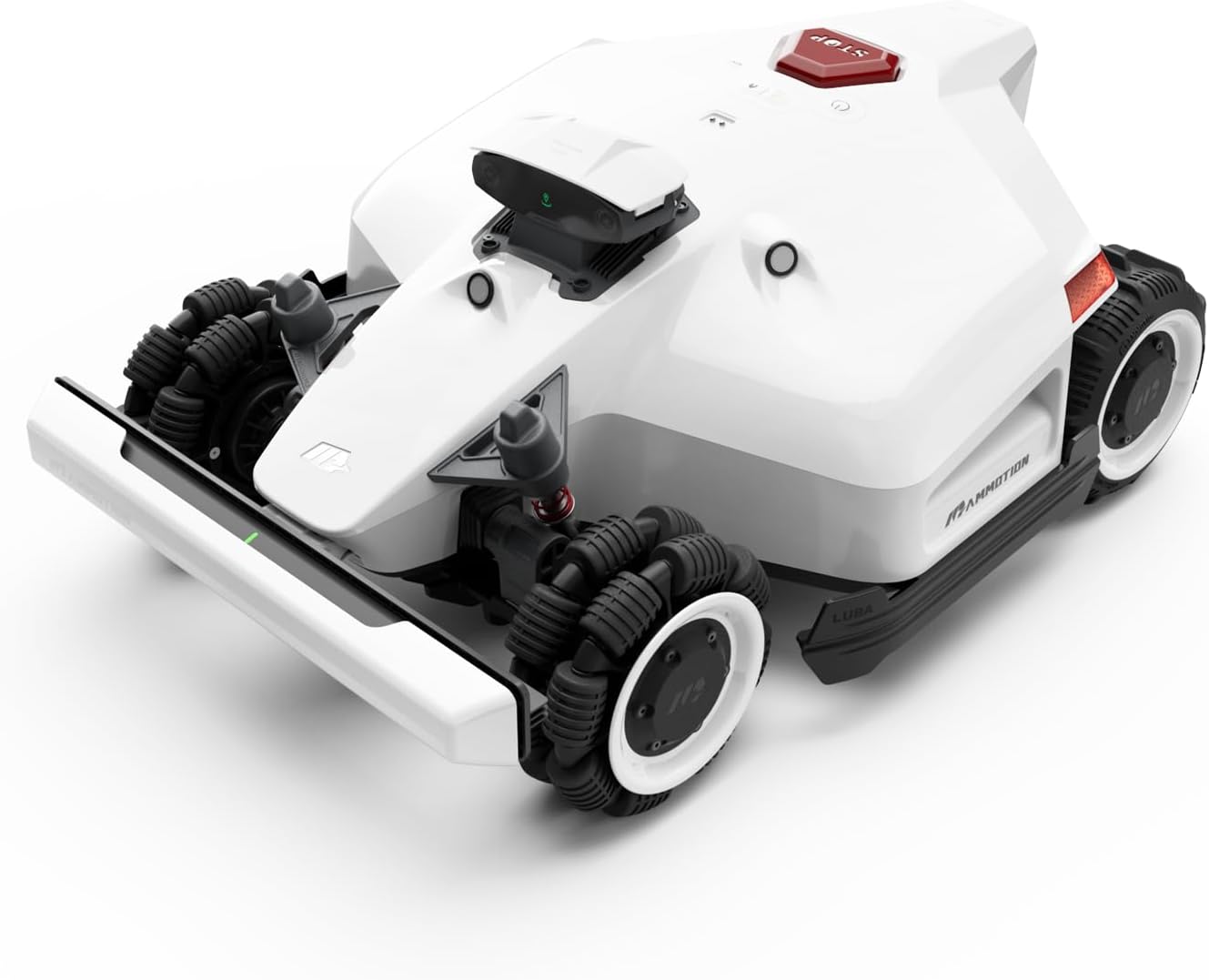Estimated reading time: 16 minutes
Introduction
The question, “Can lawn mowers fly?” propels us into an imaginative exploration at the intersection of traditional gardening tools and avant-garde technology. This inquiry is not merely a flight of fancy but a genuine probe into the realm of possibility, where the mundane task of mowing the lawn could take an extraordinary turn. As we delve into this concept, we uncover a world where the lawn mower blade could do more than just cut grass—it might soar above it. The evolution from the first lawn mowers, pushed along garden paths, to a futuristic vision where mowers come equipped with mower engines designed not just for propulsion across the yard but for a potential flight path in the sky, represents a significant leap in how we think about and equip our gardening tools. This isn’t about making lawnmowers fly for the sake of spectacle; it’s about reimagining the capabilities of lawn maintenance technology to enhance efficiency, accessibility, and sustainability.
As we venture into this exploration, we consider the practicality and feasibility of flying lawn mowers, examining the sharp blade of innovation cutting through the air of traditionalism. The transformation of a push mower into a so-called flying device encapsulates a fascinating blend of engineering prowess and creative problem-solving. This journey is not without its challenges—weight and power, stability and control, and, most importantly, safety considerations stand as significant hurdles. Yet, the potential benefits—aerial mowing the lawn, accessing hard-to-reach areas with ease, and possibly introducing an AI-driven lawn maintenance system—spark a curiosity that drives forward the quest for mowers that really fly. Through this introduction, we lay the groundwork for a comprehensive discussion on the intersection of lawn care and flight technology, inviting readers to ponder the grassy fields of the future from an elevated perspective.
Key Takeaways
- Flying Lawn Mowers: This concept combines traditional lawn care with innovative technology, exploring if lawn mowers can fly.
- Feasibility and Practicality: Examines the possibility of creating lawn mowers capable of flight and the technological challenges involved.
- Engineering and Design: Discusses the significant engineering efforts required to transform an ordinary lawn mower into a flying machine.
- Safety and Regulations: Highlights the crucial aspect of safety and regulatory considerations for potentially airborne lawn mowers.
- Future Prospects: Explores the potential future developments in lawn mower technology, including the prospect of them taking to the skies.
The Fascinating Concept of Lawn Mowers that Fly
Traditionally, lawn mowers have been confined to rolling on wheels across the lawn, tirelessly mowing your lawn to maintain the perfect amount of grass. However, the evolution of the sky cutter, a term that whimsically hints at the potential of airborne lawn mowers, suggests a future where mowers really can take to the skies. This concept pushes the envelope of innovation, turning an old lawnmower into a marvel of technology. Imagine a lawn mower that starts with the push of a controller, lifts off the ground with less than 10 pounds of effort, and hovers precisely 24 inches above the lawn, making clippings of blades of grass with an elegance previously unattainable.
As a participant in the Amazon Services LLC Associates Program, this idea could revolutionize products available on the market, offering a glimpse into a future where your lawn mower stops just as easily in the air as it does on the ground. With advancements in fuel tanks and safety shields, flying lawn mowers represent not just a leap in how we mow our lawns but a reimagining of lawn care technology itself.
Case Study: Several prototypes and conceptual designs have emerged over the years, showcasing the potential of airborne lawn mowers. These models vary from remote-controlled devices to more sophisticated designs incorporating advanced aerodynamics and propulsion systems. These prototypes testify to human ingenuity and the endless possibilities within lawn care technology.
The Role of Innovation in Lawn Mower Safety Design
Innovation has always been a driving force in the evolution of lawn mowers, from manual reel mowers to today’s automated models. The idea of a flying mower represents a significant leap forward, requiring mower safety to be redefined and new mower blades designed for aerial efficiency. This innovation isn’t just about achieving flight; it’s about enhancing efficiency, accessibility, and environmental sustainability.
Potential Benefits of Lawn Mowers That Fly
- Improved accessibility to hard-to-reach areas.
- Enhanced efficiency in large or uneven terrains.
- Reduced physical strain for the operator.
- Potential for automated, AI-driven lawn maintenance.
The Impact of Technology on Traditional Lawnmower Care
With technology that allows a mower to start with ease and stop the mower with precision mid-air, the very essence of cutting grass evolves beyond traditional methods. These innovations promise not just to maintain good working condition but to enhance productivity and safety in ways that traditional lawn mowers really haven’t before. Imagine a flying lawnmower that can effortlessly navigate above the lawn, its axle and brake system designed specifically for aerial efficiency, and a disc that ensures a uniform cut.
Brands like Toro are potentially on the brink of integrating such marvels, adhering to the safety commission‘s rigorous standards while exploring many designs that could make lawn care viral. The model plane technology, adapted for lawn care, illustrates a step-by-step revolution in how we approach the mundane task of mowing, transforming it into an experience that is as efficient as it is thrilling. This shift is not merely about novelty; it’s about redefining the parameters of what machines can do in harmony with environmental and safety considerations, taking lawn care into the skies.

Exploring the Reality: Can Lawn Mowers Fly?
The question “Can lawn mowers fly?” is a matter of curiosity and a practical inquiry into the realm of possibility and engineering. To assess the practicality of flying lawn mowers, we must consider the current state of technology, the inherent design of lawn mowers, and the physics of flight. This involves looking beyond the novelty of the idea to understand the real-world implications and technical feasibility.
Technical Challenges and Limitations
Several key challenges and limitations arise when considering flying lawn mowers:
- Weight and Power: Lawn mowers are typically heavy, and achieving lift requires significant power.
- Stability and Control: Ensuring stable and controlled flight is critical, especially when dealing with rotating blades.
- Safety Considerations: Combining flight and cutting blades poses unique safety risks.
- Cost and Practicality: The development and production costs might outweigh the practical benefits.
Engineering Hurdles in Achieving Flight
Transforming a traditional lawn mower into a flying device is a complex engineering feat. It involves overcoming significant hurdles like:
- Aerodynamic Design: Modifying the lawn mower’s design to make it aerodynamically viable for flight.
- Propulsion Systems: Develop a propulsion system strong enough to lift and maneuver the mower.
- Integration of Control Systems: Implementing advanced control systems for navigation and stability.
An aeronautics expert notes, “While the concept of flying lawn mowers presents intriguing possibilities, it also brings forth complex engineering challenges, particularly in achieving a safe and efficient flight within the constraints of lawn mower design.”
Comparing Lawn Mowers to Other Devices That Fly
When comparing lawn mowers to other flying devices, key differences become apparent:
- Purpose and Design: Unlike aircraft or drones, lawn mowers are not designed for flight, lacking the aerodynamic structure and lightweight materials.
- Operational Environment: The operational environment of a lawn mower is vastly different from that of flying devices, with safety and precision paramount.
Myth vs. Reality: Separating Fact from Fiction
In separating myth from reality, it’s clear that while the idea of flying lawn mowers captures the imagination, the practical implementation faces significant obstacles:
- Technological Limits: Current technology may not yet be advanced enough to make flying lawn mowers a practical reality.
- Regulatory Hurdles: No existing regulations or safety standards for such devices indicate a long road ahead before they could be commercially available.
While the idea of flying lawn mowers is fascinating and has captured the imagination of many, the reality of achieving such a feat is fraught with technical, safety, and practical challenges. As technology advances, this concept might become more feasible, but it remains a blend of imaginative aspiration and grounded reality for now.

The Mechanics Behind Lawn Mowers In Order To Fly
To grasp the mechanics behind flying lawn mowers, it is essential to understand the interplay of various technological elements. This involves more than just attaching propellers to a traditional mower; it requires a complete overhaul of the lawn mower’s design to accommodate flight. Key considerations include lightweight materials, propulsion systems, stability mechanisms, and safety features, all of which must work in harmony to achieve the seemingly impossible task of making a lawn mower fly.
Key Components and Their Functions in Lawn Mowers That Can Fly
| Component | Function |
|---|---|
| Propulsion System | Provides the necessary thrust to achieve and sustain flight. |
| Aerodynamic Frame | Reduces air resistance and enhances flight stability. |
| Control Systems | Allows for maneuvering and navigation of the mower in the air. |
| Safety Mechanisms | Ensures safe operation, both during flight and mowing. |
| Energy Source | Powers the mower’s flight and mowing capabilities. |
| Landing Gear | Enables safe takeoff and landing on various terrains. |
The Role of Aerodynamics in Lawn Mower To Fly
Aerodynamics plays a crucial role in the possibility of a flying lawn mower. A lawn mower must have an aerodynamic design to achieve lift and maintain stability in the air. This includes considerations for airflow over and around the mower, the weight distribution, and the propulsion system’s efficiency. The design must minimize air resistance while maximizing lift, a challenge given the traditionally bulky shape of lawn mowers.
A mechanical engineer specializing in flight mechanics states, “Designing a flying lawn mower requires a delicate balance between power and weight, as well as ensuring aerodynamic efficiency. It’s a challenging task that pushes the boundaries of conventional lawn mower design.”
Case Study: One notable case study involves a prototype flying lawn mower that achieved limited flight. This model incorporated advanced materials for its frame, a compact yet powerful engine, and a sophisticated control system for stability and navigation. While it was a proof-of-concept rather than a commercial product, this prototype demonstrated that with the right combination of technology and engineering, the concept of a flying lawn mower could move closer to reality.
The mechanics behind flying lawn mowers involve a complex integration of aerodynamics, propulsion, control systems, and safety measures. While successful prototypes show promise, turning this concept into a practical and safe reality for everyday use remains a significant challenge. The intersection of technology and traditional lawn care in this context reveals an exciting, albeit challenging, frontier in the evolution of lawn maintenance equipment.
Real-World Applications of Lawn Mowers That Fly
The intriguing idea of flying lawn mowers isn’t just a flight of fancy; it opens up potential practical applications and benefits. By transcending the limitations of traditional mowers, these flying machines could revolutionize how we approach lawn care and landscaping, offering solutions that are more efficient, accessible, and versatile.
Potential Applications in Various Fields
Flying lawn mowers could find applications across diverse fields:
- Commercial Landscaping: Enhancing efficiency in maintaining large and complex landscapes.
- Agriculture: Assisting in crop management and land maintenance.
- Residential Areas: Providing easy lawn care solutions for homeowners.
- Golf Courses: Streamlining the maintenance of vast green spaces.
- Public Parks and Recreation Areas: Offering an innovative approach to maintaining public green spaces.
Flying Lawn Mowers in Commercial Landscaping
In commercial landscaping, flying lawn mowers could significantly shift operational efficiency. These mowers could easily navigate large areas or difficult terrains, such as hills and uneven landscapes, that are challenging for traditional mowers. With the potential for remote or automated operation, they could also reduce labor costs and time spent on large-scale lawn maintenance projects.
Potential for Residential Use: Prospects and Concerns
Using flying lawn mowers in residential settings presents exciting prospects and notable concerns. Homeowners could benefit from the convenience and efficiency of these advanced mowers, particularly in yards with complex layouts or hard-to-reach areas. However, safety, noise levels, and regulatory compliance would need to be thoroughly addressed before these devices become a common sight in neighborhoods.
A landscaping professional remarks, “The application of flying lawn mowers could be a game-changer in our industry, particularly for large-scale projects. However, it’s crucial to balance innovation with practical safety measures and regulatory guidelines.”
The potential real-world applications of flying lawn mowers span various fields, offering innovative solutions to traditional lawn care and maintenance challenges. While the commercial landscaping industry could see immediate benefits, adopting in residential areas would require careful consideration of safety, noise, and regulatory aspects. As this technology progresses, it could significantly transform how we manage and maintain our outdoor spaces.

Safety and Regulations Surrounding Flying Lawn Mowers
The prospect of flying lawn mowers brings significant safety and legal considerations. As these devices would operate in a novel way, existing safety standards and regulations for ground-based lawn mowers might not be sufficient. Addressing these concerns is crucial for the practical implementation and public acceptance of flying lawn mowers.
Current Safety Standards and Regulations
Current safety standards and regulations primarily focus on traditional lawn mowers, emphasizing aspects like:
- Blade Safety: Ensuring the mower blades are securely enclosed to prevent accidents.
- Stability and Control: Standards for the stability of the mower while in operation.
- Noise Regulations: Limiting the noise produced to adhere to residential and commercial area standards.
- Emission Standards: Regulations on emissions for fuel-powered mowers.
The Importance of Proper Maintenance and Safety Measures
Proper maintenance and stringent safety measures become even more crucial for flying lawn mowers. This includes regular checks of the propulsion and navigation systems, ensuring the integrity of safety features, and training users on the unique operational aspects of these mowers. Adhering to these measures can significantly reduce the risk of accidents and malfunctions.
Case Study: A case study involving an early prototype of a flying lawn mower highlights the importance of safety. The prototype experienced a malfunction during a test flight, leading to a loss of control. This incident underscores the need for robust safety protocols, especially in emergencies, and the importance of extensive testing before commercial deployment.
Regulatory Challenges and Compliance
The development of flying lawn mowers introduces a new set of regulatory challenges. These include creating new standards for aerial operation, ensuring compliance with airspace regulations, and establishing guidelines for residential and commercial use. Navigating these regulatory landscapes is essential for the safe and legal operation of flying lawn mowers.
Consumer Safety: What You Need to Know
Understanding the safety implications is key for consumers considering the use of flying lawn mowers. This includes awareness of the operational limits, the importance of adhering to manufacturer guidelines and staying informed about any regulatory changes affecting their use.
Integrating flying lawn mowers into mainstream use involves navigating a complex web of safety and regulatory considerations. Ensuring the safety of these devices through proper maintenance, understanding the lessons from past incidents, and complying with evolving regulations are critical steps in making flying lawn mowers a safe and accepted technology in lawn care and maintenance.
The Future of Lawn Mowers: Flying Models on the Horizon?
The idea of flying lawn mowers might seem like a concept from science fiction, but it is increasingly becoming a topic of serious discussion among innovators and manufacturers. Predicting the future of lawn mowers involves looking at emerging technologies, consumer demands, and environmental considerations. It’s about understanding how these factors could shape the next generation of lawn mowers.
Case Study: A recent case study highlights a prototype integrating drone technology with traditional mowing mechanisms. This prototype uses GPS for navigation and has an advanced collision-avoidance system, representing a significant step towards autonomous flying mowers. It showcases how integrating new technologies can revolutionize lawn mower design.
Innovations Shaping the Next Generation of Lawn Mowers
Several innovations are set to shape the future of lawn mowers:
- Autonomous Navigation: Incorporating AI for autonomous, precise mowing.
- Electric Propulsion: Transitioning to electric engines for eco-friendliness and efficiency.
- Smart Connectivity: Using IoT for remote monitoring and control.
- Advanced Safety Features: Implementing sophisticated safety protocols for ground and aerial operations.
Environmental Impact and Sustainability Considerations
As we move towards potential flying lawn mowers, environmental impact, and sustainability become pivotal factors. These mowers must be designed with eco-friendly materials, energy-efficient engines, and minimal noise pollution to be viable in a world increasingly focused on sustainability.
Comparison of Traditional vs. Flying Lawn Mowers
| Feature | Traditional Lawn Mower | Flying Lawn Mower |
|---|---|---|
| Operation | Ground-based, manual, or automated | Aerial, potentially autonomous |
| Energy Source | Gasoline, electric, or manual | Primarily electric |
| Navigation | Manual steering or basic GPS | Advanced GPS and AI-based systems |
| Safety Features | Blade guards, emergency stops | Collision-avoidance, emergency landing |
| Environmental Impact | Emissions from gasoline models | Reduced footprint with electric propulsion |
Market Predictions and Consumer Interest
Market predictions for flying lawn mowers are cautiously optimistic. Consumer interest is growing, especially among tech-savvy individuals and those in industries like landscaping and agriculture. As technology advances and costs decrease, these mowers are expected to gain popularity, provided safety and regulatory challenges are adequately addressed.
The future of lawn mowers, with the possibility of flying models, looks promising but is contingent on several factors. Technological advancements, consumer needs, environmental considerations, and safety regulations will all play a role in determining if and when flying lawn mowers become a common tool in lawn maintenance. While there are challenges to overcome, the potential for innovation and improvement in lawn care is significant, making this an exciting area to watch in the coming years.
- Perimeter Wire Free Vision Robotic Lawnmower
- For 1.25 Acres Lawn, Cut Height 2.2"-4.0", 80% Slope
- APP Control Compatible with Alexa
- All-Wheel Drive, Anti-Theft
Conclusion
In the captivating realm of lawn care technology, the question of whether can lawn mowers fly is not just a curiosity but a vibrant topic of inquiry. As we venture into the future, the transformation of the traditional riding mower into a flying marvel is an exhilarating prospect. Envision a mower that turns off the mower with a simple remote control, lifts 10 pounds effortlessly, and hovers 24 inches above the ground, revolutionizing how we approach the chore of cutting grass. With advanced spin capabilities and a safety commission-approved design, these mowers could navigate around debris, operate 4 inches high, and span 36 inches wide, ensuring a neatly manicured lawn with unprecedented precision and ease.
The evolution from walk-behind mowers to aerial units involves integrating internal combustion engines with sophisticated prop and pushrod systems, managed via a radio controller. This transition not only enhances the mower’s lifespan but also its ability to handle diverse terrains, from the freshly cut residential yards to expansive commercial landscapes. By adhering to stringent safety precautions and ensuring all mowers are well-maintained, the leap into aerial mowing is poised to redefine the boundaries of traditional lawn care, making the dream of flying mowers a tangible glimpse into the future of outdoor maintenance.
James Dunnington leads the James Dunnington Collection, featuring five unique blogs: a practical Pet Care Guide, an enlightening Ancient History Blog, a resourceful Home Improvement Guide, a cutting-edge Tech Innovation Guide, and a strategic Online Money Making platform. Each site delivers valuable insights designed to empower and inform. For updates and more tips, visit our Contact Us page to sign up for our newsletter, ensuring you never miss out on the latest content from any of these dynamic fields.

